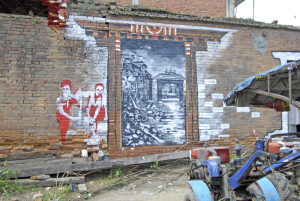Healing touch of art
 Bhaktapur
Bhaktapur
Georges Barque has said, “Art is a wound turned into light” — and ArTree Nepal, a group of contemporary artists who strive to create artworks with social significance and utility, responded to the devastation caused by the April 25 earthquake by initiating ‘12 Baisakh’ aiming to align artistic interests with social practices.
The group worked with the residents of Thulo Byasi, Bhaktapur since April 28. ‘12 Baisakh’ evolved over two phases — Phase I focused on immediate relief, documentation, research and community support, while Phase II is focused on the development of long-term artistic engagements, including a showcase of communal experiences through site-specific works and research called Camp.Hub.
At a press meet on September 14 at Siddhartha Art Gallery, Babermahal, Sheelasha Rajbhandari, Co-founder/Director of ArTree Nepal, gave a Powerpoint presentation on the works that is in progress and done at ThuloByasi, Bhaktapur. The day also became one to visit the site to see how more than 40 artists are working. From September 18 to 20, everyone is welcome to experience Camp.Hub.
 In Camp.Hub, one could see murals/graffiti, site-specific installations, multimedia interactive installation, artwork created in collaboration with the local children and women, traditional mural paintings, children’s art exhibition, local music and cultural performances, among others.
In Camp.Hub, one could see murals/graffiti, site-specific installations, multimedia interactive installation, artwork created in collaboration with the local children and women, traditional mural paintings, children’s art exhibition, local music and cultural performances, among others.
The first thing one notices reaching the site is the huge colourful as well as black and white murals /graffiti by Sudeep Balla, Balkrishna Banmala and Narayan Bohaju; traditional murals by Samundraman Shrestha, Shree Bhakta Prajapati and Bikash Tamakhu.
These artists have used the walls of the houses damaged in the quake and managed to impart a pleasant feeling in abandoned broken houses through colours and their imagination.
In one of the murals by Balla, he has created a boy having good time — jumping over several TV sets. Banmala has focused on traditional architecture and the need to preserve the tradition of the locality.
He has painted a wooden traditional door and inside the door he has painted the condition of Thulo Byasi after the quake in black and white. About his mural, Banmala expressed, “Bhaktapur is known as the ancient city and after the earthquake, most of the ancient architectural structures collapsed. Now people plan to make modern buildings instead of following the traditional architectural style. So, the reason behind my painting the door is to give the message that Bhaktapur should preserve its ancient heritage or its identity is lost forever.”
Meanwhile, Bohaju has created his murals at temporary shelters made of CGI sheets. In black and white, he has painted various things used in household like gas cylinder, table, chair, kitchen utensils, et cetera in a linear way.
For him the things used in houses are the soul of house and after the earthquake people have had to migrate from their homes where the images in line suggest their path of migration. His artwork on the CGI sheets seem to give life to those shelters and his work is also in demand in the locality.
Bina Koju and Keshari Suwal are local women who are professional knitters with whom Rajbhandari has collaborated. So here one can see the coming together of their skill and art. Under Rajbhandari’s supervision, these women have knit their own portraits. Suwal shared, “I have never created portraits before and I thought it would be difficult, but I enjoyed it and found it easier than I expected.”
Here almost all females knit and have been supporting the family with this skill of theirs.
Talking about the locality before the earthquake, 65-year-old Sundari Kaitu expressed, “Our place used to be happening — people used to gather at phlacha (traditional resting place) and till 1:00 am people used to be involved in various activities. But now around 7:00 pm the locality turns silent.”
According to Nabin Basukala, another local, the art activities around the area have helped to create a different environment for people living here.
A version of this article appears in print on September 15, 2015 of The Himalayan Times.